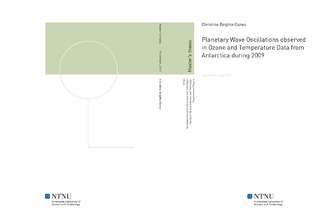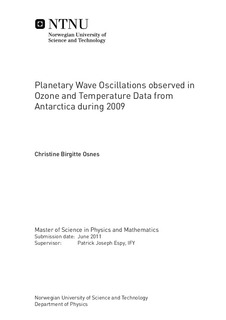| dc.contributor.advisor | Espy, Patrick Joseph | nb_NO |
| dc.contributor.author | Osnes, Christine Birgitte | nb_NO |
| dc.date.accessioned | 2014-12-19T13:16:59Z | |
| dc.date.available | 2014-12-19T13:16:59Z | |
| dc.date.created | 2011-09-15 | nb_NO |
| dc.date.issued | 2011 | nb_NO |
| dc.identifier | 441347 | nb_NO |
| dc.identifier | ntnudaim:6687 | nb_NO |
| dc.identifier.uri | http://hdl.handle.net/11250/246509 | |
| dc.description.abstract | Ozone and temperature data from Troll and Rothera research stations has been analyzed in order to trace planetary waves. Seasonal variations were removed and spectral analysis was performed in order to find dominating frequencies. Possible planetary wave oscillations were found in the 4, 5, 8.5, 10-11, 11-13, 14-15, 17-20, 21-24 and 26-45 day bands, some corresponding to the atmospheric normal modes. These were found consistently in both the ozone and temperature data, indicating that the millimeter wave spectroscopy used to measure the ozone is a viable technique for tracing planetary waves in a region of the atmosphere where other measurements are sparse. | nb_NO |
| dc.language | eng | nb_NO |
| dc.publisher | Institutt for fysikk | nb_NO |
| dc.subject | ntnudaim:6687 | no_NO |
| dc.subject | MTFYMA fysikk og matematikk | no_NO |
| dc.subject | Teknisk fysikk | no_NO |
| dc.title | Planetary Wave Oscillations observed in Ozone and Temperature Data from Antarctica during 2009 | nb_NO |
| dc.type | Master thesis | nb_NO |
| dc.source.pagenumber | 78 | nb_NO |
| dc.contributor.department | Norges teknisk-naturvitenskapelige universitet, Fakultet for naturvitenskap og teknologi, Institutt for fysikk | nb_NO |

